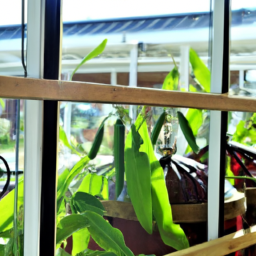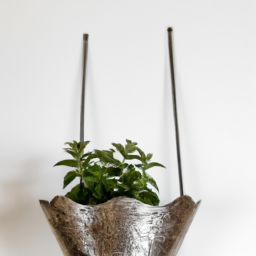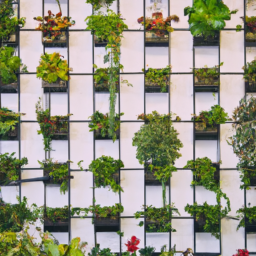
Are you looking for creative ways to bring more greenery into your living space? Vertical Garden Solutions: Maximizing Space with Vertical Plant Displays is the perfect blog post for you. In this article, we will explore the concept of vertical gardening and how it can help you make the most of limited space while adding a touch of natural beauty to your surroundings. Whether you live in a small apartment or have a tiny backyard, vertical plant displays offer a practical and visually appealing solution to maximize your gardening potential. So, let’s dive in and discover the endless possibilities of vertical gardens!
Benefits of Vertical Gardens: Exploring the Advantages of Vertical Plant Displays
Vertical gardens, also known as living walls or green walls, have gained significant popularity in recent years. These innovative gardening solutions allow individuals to maximize their space by growing plants vertically, creating stunning displays that not only enhance the aesthetic appeal but also offer numerous benefits. In this article, we will delve into the advantages of vertical plant displays and explore why they have become such a popular choice for urban dwellers, gardening enthusiasts, and environmentalists alike.
Enhanced Space Utilization
One of the primary benefits of vertical gardens is their ability to maximize space utilization. In urban environments where space is limited, vertical plant displays offer an excellent solution for individuals who want to enjoy the beauty of nature without sacrificing valuable floor space. By growing plants vertically, you can transform walls, fences, or even unused vertical structures into vibrant green spaces, adding life and color to otherwise dull areas.
Vertical gardens are particularly beneficial for small apartments, balconies, or rooftops, where traditional gardening methods may not be feasible due to space constraints. With vertical plant displays, you can create a lush oasis even in the smallest of spaces, bringing the joy of gardening to urban dwellers who may not have access to traditional gardens.
Furthermore, vertical gardens can be designed to fit any space, allowing for customization and flexibility. Whether you have a narrow alleyway or a large outdoor area, vertical plant displays can be tailored to suit your specific needs, making them a versatile option for any location.
Improved Air Quality
Another significant advantage of vertical gardens is their ability to improve air quality. Plants naturally absorb carbon dioxide and release oxygen through photosynthesis, helping to purify the air we breathe. By incorporating a vertical garden into your living or working space, you can create a natural air filtration system that removes harmful pollutants and toxins, promoting a healthier environment.
Studies have shown that vertical gardens can significantly reduce indoor air pollution, particularly in areas with limited ventilation. The plants act as natural air purifiers, removing toxins such as formaldehyde, benzene, and volatile organic compounds (VOCs) that are commonly found in indoor environments. This can have a positive impact on your overall well-being, reducing the risk of respiratory problems, allergies, and other health issues associated with poor air quality.
Furthermore, vertical gardens can also help to regulate humidity levels, particularly in dry or arid climates. The plants release moisture into the air through a process called transpiration, which can help to create a more comfortable and pleasant indoor environment.
Increased Biodiversity
Vertical gardens provide an opportunity to increase biodiversity in urban areas, which are often characterized by concrete jungles devoid of green spaces. By incorporating a variety of plant species into your vertical garden, you can attract birds, butterflies, and other beneficial insects, creating a mini-ecosystem within your own space.
Vertical gardens can act as a refuge for pollinators, helping to support local ecosystems and promote biodiversity. By choosing a diverse range of plants, including native species, you can provide food and shelter for a wide array of wildlife, contributing to the conservation of local flora and fauna.
In addition to supporting wildlife, vertical gardens can also help to reduce the urban heat island effect, a phenomenon where urban areas experience higher temperatures than surrounding rural areas. The plants in vertical gardens provide shade and evaporative cooling, helping to mitigate the heat and create a more pleasant microclimate.
In conclusion, vertical gardens offer numerous benefits that make them an attractive option for individuals looking to maximize their space while enjoying the beauty of nature. From enhanced space utilization to improved air quality and increased biodiversity, vertical plant displays provide a unique and innovative solution for urban gardening. Whether you have a small apartment, a rooftop, or a large outdoor area, vertical gardens can transform any space into a vibrant green oasis.
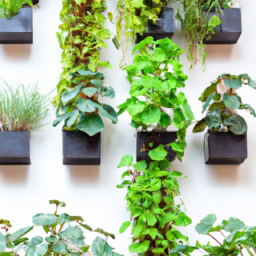
Designing a Vertical Garden: Tips and Tricks for Creating a Space-Saving Vertical Plant Display
Welcome to the world of vertical gardening! If you’re looking to maximize your space and create a stunning plant display, vertical gardens are the way to go. In this guide, we will walk you through the process of designing a vertical garden, offering you tips and tricks along the way.
1. Assessing Your Space
Before diving into the design process, it’s essential to assess your space. Take a look at the area where you plan to install your vertical garden. Consider factors such as sunlight exposure, access to water, and the overall aesthetic of the space.
Once you have a clear understanding of your space, you can start planning the layout and selecting the right plants. Make sure to choose plants that thrive in the available lighting conditions and require minimal maintenance.
Additionally, consider the weight-bearing capacity of the wall or structure you’ll be attaching your vertical garden to. It’s crucial to ensure that the support can handle the weight of the plants, soil, and any additional irrigation systems.
2. Choosing the Right Structure
The next step in designing your vertical garden is selecting the right structure. There are various options available, including vertical planters, trellises, and modular systems. Each option has its advantages, so choose the one that suits your space and design preferences.
Vertical planters are ideal for smaller spaces as they can be easily mounted on walls or fences. Trellises provide support for climbing plants and add a touch of elegance to your garden. Modular systems offer flexibility and allow you to create custom configurations.
Consider the material of the structure as well. Wood, metal, and plastic are commonly used materials. Ensure that the structure is durable, weather-resistant, and capable of supporting the weight of your plants.
3. Plant Selection and Placement
Now comes the exciting part – selecting and placing your plants. When choosing plants for your vertical garden, opt for a mix of different textures, colors, and growth habits. This will create visual interest and make your garden more vibrant.
Consider the mature size of the plants to ensure they won’t outgrow the available space. You can mix trailing plants, such as ivy or creeping jenny, with upright plants like ferns or herbs. This combination will add depth and dimension to your vertical garden.
When placing the plants, take into account their light and water requirements. Position shade-loving plants in areas with less direct sunlight, while sun-loving plants should be placed in sunnier spots. Group plants with similar water needs together to simplify irrigation.
4. Irrigation and Maintenance
Proper irrigation is crucial for the success of your vertical garden. Consider installing an irrigation system that delivers water directly to the roots of the plants. Drip irrigation or micro-sprinkler systems are popular choices for vertical gardens.
Regular maintenance is also essential to keep your vertical garden thriving. Monitor the moisture levels of the soil and adjust your watering schedule accordingly. Prune and trim the plants as needed to maintain their shape and prevent overcrowding.
Inspect your vertical garden regularly for pests or diseases. Early detection and treatment can prevent the spread of any issues and keep your plants healthy.
Conclusion
Designing a vertical garden is a rewarding and creative process. By assessing your space, choosing the right structure, selecting suitable plants, and providing proper irrigation and maintenance, you can create a stunning space-saving vertical plant display.
Remember to regularly evaluate your vertical garden’s performance and make adjustments as needed. With time and care, your vertical garden will become a beautiful focal point and a source of joy for all who see it.
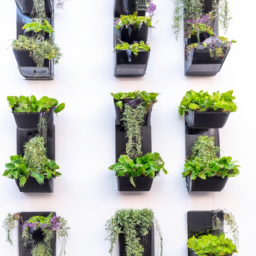
Vertical Garden Solutions for Small Spaces: Maximizing Space with Vertical Plant Displays in Apartments and Urban Environments
Are you an urban dweller with limited space but a desire to bring nature into your living environment? Vertical garden solutions offer a perfect way to maximize space and create stunning displays of plants in apartments and urban settings. In this guide, we will explore the benefits of vertical gardens, the different types of vertical garden systems available, and provide a step-by-step guide to help you create your own vertical plant display.
The Benefits of Vertical Gardens
Vertical gardens, also known as living walls or green walls, are not only aesthetically pleasing but also offer numerous benefits for small spaces. Here are some advantages of incorporating vertical garden solutions:
1. Maximizing Space: Vertical gardens allow you to utilize vertical wall space, making them perfect for small apartments or urban environments where horizontal space is limited. By going vertical, you can still enjoy the beauty of plants without sacrificing valuable floor space.
2. Improved Air Quality: Plants naturally purify the air by removing toxins and releasing oxygen. Vertical gardens can help improve indoor air quality, especially in urban areas where pollution levels are higher.
3. Noise Reduction: The dense foliage of vertical gardens can act as a natural sound barrier, reducing noise pollution and creating a more peaceful living environment.
Types of Vertical Garden Systems
There are various types of vertical garden systems available, each with its own unique features and benefits. Here are three popular options:
1. Vertical Pockets: Vertical pocket systems consist of pockets or pouches attached to a backing material, such as felt or fabric. These pockets are then filled with soil and plants. This system is lightweight, easy to install, and allows for flexibility in plant selection.
2. Modular Panels: Modular panel systems are pre-fabricated panels that can be easily mounted on walls. These panels typically have built-in irrigation systems and can support a wide variety of plant species. They provide a more structured and uniform look to your vertical garden.
3. Trellis Systems: Trellis systems use a framework of vertical posts and horizontal supports to create a structure for climbing plants. These systems are ideal for vine plants such as ivy or jasmine. Trellis systems offer a more organic and natural look to your vertical garden.
Step-by-Step Guide to Creating Your Vertical Plant Display
Now that you understand the benefits of vertical gardens and the different types of systems available, let’s dive into the step-by-step process of creating your own vertical plant display:
Step 1: Assess Your Space: Take a look at the available wall space in your apartment or urban environment. Consider factors such as sunlight exposure, accessibility for watering, and the weight-bearing capacity of the wall.
Step 2: Choose the Right System: Select a vertical garden system that suits your space and preferences. Consider factors such as ease of installation, maintenance requirements, and the types of plants you want to grow.
Step 3: Prepare the Wall: Clean the wall surface and ensure it is free from any dirt or debris. If necessary, apply a waterproof membrane to protect the wall from moisture damage.
Step 4: Install the Vertical Garden System: Follow the manufacturer’s instructions to install the chosen vertical garden system. Ensure that it is securely attached to the wall and can bear the weight of the plants and soil.
Step 5: Choose and Plant Your Plants: Select plants that are suitable for your chosen system and the available sunlight in your space. Consider factors such as plant size, growth habits, and maintenance requirements. Plant your chosen plants in the pockets, panels, or trellis of the vertical garden system.
Step 6: Water and Maintain: Regularly water your vertical garden to keep the plants hydrated. Follow the specific watering guidelines provided by the vertical garden system manufacturer. Monitor the plants for any signs of pests or diseases and take appropriate measures to maintain their health.
Step 7: Enjoy Your Vertical Garden: Sit back, relax, and enjoy the beauty of your vertical plant display. Take time to appreciate the benefits it brings to your living environment and the joy it brings to your daily life.
By following these steps, you can create a stunning vertical garden in your small space, maximizing the use of vertical walls and bringing nature into your urban environment.
In conclusion, vertical garden solutions offer a practical and visually appealing way to maximize space and create beautiful plant displays in apartments and urban environments. Whether you choose vertical pockets, modular panels, or trellis systems, the benefits of vertical gardens are numerous. Follow the step-by-step guide provided to create your own vertical plant display and enjoy the beauty and benefits it brings to your living space.
Key Takeaways
If you’re a plant lover but don’t have much space to work with, vertical garden solutions could be the answer to your gardening dreams. Vertical plant displays are a clever way to maximize space and create a stunning green oasis in even the smallest of areas. Whether you have a cramped balcony, a tiny backyard, or even just a blank wall in your home, there are plenty of options available to turn that unused space into a flourishing garden.
One popular solution for vertical gardens is using hanging pots or planters. These can be easily attached to walls or hung from the ceiling, allowing you to grow a variety of plants without taking up valuable floor space. Another option is to use a trellis or a grid system to support climbing plants, such as ivy or jasmine. By training these plants to grow vertically, you can create a beautiful living wall that adds a touch of nature to any space. Additionally, there are modular systems available that allow you to stack and arrange planters in different configurations, giving you complete control over the design and layout of your vertical garden. So, no matter how limited your space may be, vertical garden solutions offer a creative and practical way to bring the beauty of nature into your surroundings.
Q&A Corner:
Q1: What is a vertical garden?
A1: A vertical garden, also known as a living wall or green wall, is a method of growing plants vertically rather than horizontally. It involves using specially designed structures or systems to support plants and allow them to grow on walls, fences, or other vertical surfaces.
Q2: How can a vertical garden maximize space?
A2: Vertical gardens are an excellent solution for maximizing space, especially in urban environments where horizontal space is limited. By utilizing vertical surfaces, such as walls or balconies, you can transform unused areas into lush green spaces for growing plants. This way, you can enjoy the benefits of gardening even in small spaces.
Q3: What are the benefits of vertical gardens?
A3: Vertical gardens offer several benefits. Firstly, they allow you to grow a variety of plants in a limited space, making it ideal for urban dwellers or those with small yards. Secondly, they enhance air quality by reducing pollutants and increasing oxygen levels. Additionally, vertical gardens can insulate buildings, reducing energy consumption, and provide a visually appealing and calming environment.
Q4: What types of plants are suitable for vertical gardens?
A4: Many plants are suitable for vertical gardens, including various herbs, flowers, and even some vegetables. Some popular choices are trailing plants like ivy or ferns, which naturally grow downwards, as well as plants with compact growth habits like succulents or small ornamental grasses. It’s important to consider the specific lighting and environmental conditions of your space when selecting plants.
Q5: What are the maintenance requirements for vertical gardens?
A5: Maintenance requirements for vertical gardens can vary depending on factors such as plant selection, climate, and the type of system used. Generally, regular watering, pruning, and fertilizing are necessary to ensure healthy plant growth. Additionally, periodic inspections for pests or diseases and the occasional cleaning of the vertical structure may be required. It’s essential to follow the specific care instructions for the plants and system you choose.

Lisa Chen is a seasoned indoor gardening expert and the author of several bestselling books on the topic. With a background in horticulture and urban farming, Lisa is dedicated to helping urban dwellers embrace the joys of cultivating green spaces indoors. Her detailed guides and hands-on tips empower readers to transform their living spaces into thriving plant sanctuaries.

